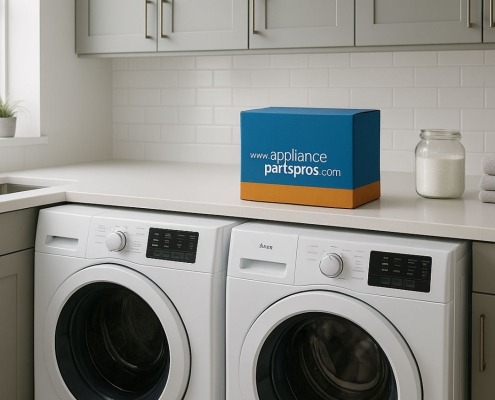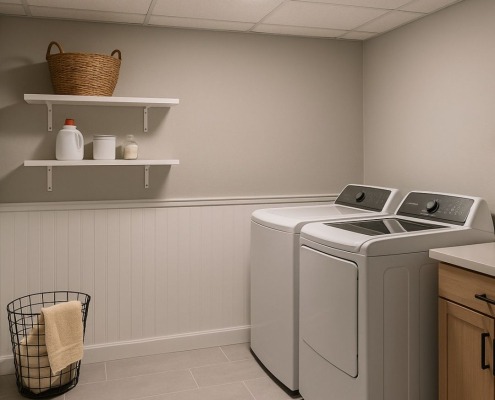How to replace the bleach dispenser on a Whirlpool washer
Steven E / Tuesday April 22, 2025
Is your Whirlpool washer’s bleach dispenser causing headaches with its stubborn leaks or clogs? Don’t let a malfunctioning bleach dispenser ruin your laundry day! Whether it’s not dispensing bleach at the right time or leaking all over your laundry room, this problem is easier to fix than you might think. Watch our step-by-step guide video below and learn how to replace it quickly and safely, bringing your washer back to peak performance.
Looking for the right part? Enter your appliance model number below to find the exact match and get your appliance running like new again!
On a Whirlpool washer, the bleach dispenser is responsible for automatically dispensing bleach at the right time during the wash cycle, allowing your washer to use bleach for whitening and stain removal without damaging clothes.
Common signs that indicate the need for replacement include bleach not dispensing properly, leaks around the dispenser area, or the dispenser becoming clogged or not filling and draining correctly.
Fortunately, with a few basic tools and some patience, you can tackle this repair yourself and get your washer back in working order. So, let’s get started!
You can find a replacement bleach dispenser here. If you need other replacement parts for your Whirlpool washer, just enter your model number at AppliancePartsPros.com to find them. It’s that easy! Most orders arrive in just two business days, and we have thousands of guides to show you how to install your new parts.
Watch here: How To: Whirlpool/KitchenAid/Maytag Bleach Dispenser WPW10187307
The information in this article may not apply to your specific appliance model. We recommend consulting your manufacturer’s documentation or contact us with any questions.
Tools and materials
- Replacement part (make sure it’s compatible with your model before installing)
- 1/4″ nut driver
- Pliers
- Retaining strap
The specific tools required may vary depending on the model of your appliance and the type of fasteners used on it.
Safety precautions
When working on any appliance, remember to keep safety first. Here are some tips to keep in mind:
- Always power off and unplug your appliance or switch off the circuit breaker before attempting any maintenance or replacement work. This keeps you safe by preventing any risk of injury from electric shock.
- Turn off the water supply at the outlet before beginning repairs to any appliance parts that hold water. Have towels ready for any residual water in the system when removing parts.
- Wear insulated work gloves to protect your hands from sharp metal parts, pinching hazards and debris.
- Don’t test wiring with a multimeter for live voltage if you’re unfamiliar with how to prevent short circuiting when testing.
- When working with wires, avoid touching any exposed wires or terminals. If you need to touch a wire, use a non-conductive tool or wear insulating gloves to prevent electrical shock.
- Take your time and don’t rush while working to prevent accidents and personal injuries.
- Work in a well-lit area so you can clearly see and access the interior parts.
- Clear your workspace of clutter and other obstacles. Keep children and pets away from the work area.
- Never work on internal parts with bare wet hands. Make sure the work area is completely dry.
- Check your user manual to see if there are specific installation or safety instructions for your part or appliance.
- Be gentle when handling or removing parts. Excessive force might damage the appliance or cause injury.
- Wear safety glasses when working with chemicals, dust or cleaning large debris to prevent injury.
- If the appliance has recently been used, give it plenty of time for any heating parts to cool down before working on it.
- Take pictures or make a note of wiring connections before disconnecting to prevent any problems with reassembly.
Replacement steps
Step 1: Disassembly
- Locate and remove the corner screws at the back of the washer that hold the top in place. Leave the bottom screws in as they are attached to the hinge.
- Open the lid of the washer and pull the top panel forward. Pull it forward, and lift it up. Set it aside for now.
- Push the bezel in and lift it up to release it from its position.
- Squeeze the tabs on the sides of the dispenser and press it down to release it from its mounting.
- Lift the top panel slowly and use a strap to hook it up at the top and bottom. Place a towel underneath to catch any water that may drip down.
- Use pliers to squeeze the clamp on the hose and move it off. Pull the hose off the water inlet valve and release it from the clamp.
- Take out the old dispenser by sliding it out from its cutout.
Step 2: Reassembly
- Slide the new dispenser into the cutout.
- Place the hose back onto the water inlet valve and secure it with the locking clamp.
- Use pliers to squeeze and slide the clamp into position.
- Remove the towel from underneath the washer. Release the strap and lower the top panel back into place.
- Position the bezel with the rear side going over the tab. Press down firmly to secure it in place.
- Lift the top panel up, pull it forward, press it down, and push it back to close it.
- Close the lid of the washer and secure the top panel at the back with a couple of quarter-inch screws.
- Plug the washer back in and turn the water back on.
- Test the washer to check for any problems.
Additional information
Thanks for reading! We hope this guide helped you replace the bleach dispenser on your Whirlpool washer.
If you still need some replacement parts, grab your model number and head over to AppliancePartsPros.com. We offer over two million parts and most orders arrive in two business days. If you need some help with finding the right part or placing an order, you can contact our team at 1 (877) 477-7278.
While you’re waiting for your new part to arrive, you can explore our DIY blog and watch thousands of video tutorials on our YouTube channel.
Be sure to follow us on Facebook, Twitter and Instagram to see our latest repair guides!
With nearly a decade of experience in providing top-notch customer service regarding appliance parts and repair, Steven enjoys sharing practical advice, troubleshooting tips, and interesting information to help readers stay informed.





